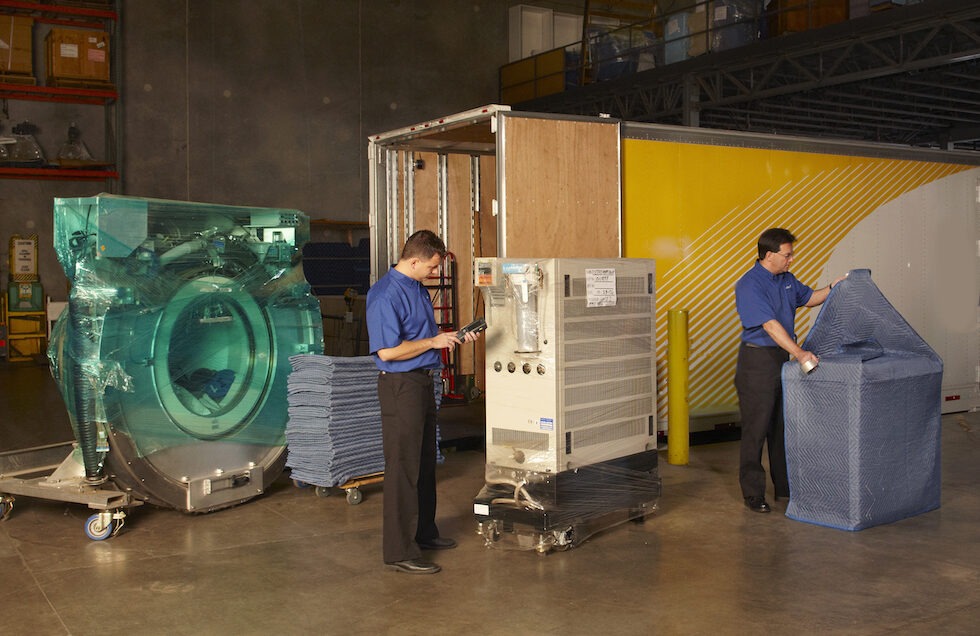Unlocking Value Through Reverse Logistics of Capital Equipment
Against today’s backdrop of tariffs, economic pressures and supply chain challenges, organizations are doubling down on efforts to reduce waste and recover value from their operations. One area with significant untapped potential is reverse logistics of capital equipment.
When high-value assets like medical imaging systems, diagnostic analyzers, or cash recyclers reach the end of their lifecycle, their story doesn’t end at the point of use. For many manufacturers, the process of retrieving, refurbishing, and responsibly managing these assets isn’t simply a logistical afterthought; it’s a strategic function that protects asset value, ensures regulatory compliance, and drives sustainability.
Done well, reverse logistics can mean the difference between millions in recovered value and costly write-offs. Following is summary of what should be considered with a reverse logistics program for your capital equipment.
Refurbish & Resell: Maximizing Asset Recovery
In industries where a single device can be worth tens or even hundreds of thousands of dollars, the ability to efficiently return, inspect, refurbish, and redeploy equipment is a financial imperative. A robust reverse logistics program enables manufacturers to:
- Extend lifecycle value by transforming used equipment into certified pre-owned inventory.
- Capture new market segments by offering refurbished devices to price-sensitive buyers.
- Reduce environmental impact by minimizing the need for new production.
However, gaps in reverse logistics can be costly. Incomplete or inconsistent solutions risk diminished resale value, or worse – legacy devices competing on secondary resale markets outside of your control. For manufacturers under regulatory oversight, the stakes are even higher. Proper reverse logistics ensure every device tied to your brand is accounted for throughout its lifecycle, protecting your company from potential liability.
Managing Internal Inventory: Demo, Evaluation & Marketing Assets
High-cost demo units, evaluation devices, service loaners, and marketing assets are often among the most under-tracked equipment within a manufacturer’s ecosystem. Without proper oversight, these valuable assets can easily fall into logistical black holes, leading to wasted resources and lost opportunities.
An effective reverse logistics process empowers teams by:
- Maintaining visibility and accountability for assets across a distributed network.
- Ensuring demo and loaner equipment remains in optimal condition for the next use.
- Supporting high-quality sales demonstrations and marketing engagements that can mean the difference between closing a deal and missing out.
By introducing inspection checkpoints at key transfer points (such as between customer sites and internal teams) manufacturers can protect asset integrity and maximize sales potential.
Trade-In and Swap Programs: Coordinated Delivery & Removal
The replacement of legacy systems (whether a surgical laser console or a branch-based cash recycler) requires seamless synchronization between new order fulfillment and the retrieval of outdated equipment. Reverse logistics plays a pivotal role in ensuring this process is smooth and efficient.
Manufacturers that can offer customers a coordinated delivery, installation, and removal process:
- Enhance customer satisfaction with a seamless transition.
- Minimize downtime, which is especially critical in healthcare and financial services.
- Ensure legacy assets don’t get stranded in the field, lost, or unaccounted for.
This level of coordination not only improves customer experience but also strengthens brand trust and long-term loyalty.
A Single Source Partner Maintains Supply Chain Integrity
Reverse logistics of capital equipment isn’t just a backend process, it’s a strategic enabler of revenue recovery, regulatory compliance, and sustainability. By investing in efficient reverse logistics solutions, manufacturers can extend asset lifecycles, better serve their customers, and protect their brands. Better yet, partnering with a single-source provider such as TechTrans ensures seamless supply chain management, giving companies the confidence that every step of their reverse logistics program is optimized to maximize value.
Streamlining Equipment Deployments with Seamless Logistics
How TechTrans Minimizes Downtime Through Integrated Delivery and Installation Services
No matter if it’s a diagnostic-critical machine for a healthcare facility, an install of a new IT data bank, or a roll-out of new kiosks, self-check-out machines or cash recyclers for retail locations nationwide, no manufacturer wants a gap between the delivery of the equipment and when it can be installed. It’s a frustrating, costly interruption that disrupts schedules, delays productivity, and stretches customer patience.
Traditional logistics models often involve multiple handoffs between transportation carriers, installation teams, and customer coordinators — increasing the risk of delays, miscommunication, and extended downtime.
TechTrans is transforming this process.
As a turnkey logistics provider specializing in White Glove transportation services, TechTrans offers a fully integrated solution that bridges the gap between standard delivery and technical installation. Through our unique blend of transportation expertise and product-specific technical capabilities, we help shippers streamline equipment deployments from pickup to power-up.
A Single, Seamless Solution from Pickup to Installation
TechTrans distinguishes itself by offering both routine transportation and technical delivery services under one roof. Unlike conventional carriers that stop at the point of delivery, our trained and certified drivers go beyond the drop-off. We routinely provide:
- Inside delivery
- Unpacking and debris removal
- Equipment placement
- Assembly and basic power-up functions
This combination simplifies the process for shippers and their customers, eliminating the need to schedule separate installation teams and reducing the burden on service engineers, sales representatives, or customer personnel who might otherwise have to coordinate post-delivery activities.
The result? A single scheduling appointment that combines delivery and installation, ensuring faster, more predictable equipment deployment with minimal downtime.
Nationwide Flexibility and Control
With a robust national network of local delivery teams and strategically located service centers, TechTrans provides shippers with exceptional flexibility and control. Our ability to hold shipments in transit at one of our many facilities gives customers the breathing room they need when schedules shift — whether due to last-minute customer changes, site readiness delays, or unforeseen construction issues.
Rather than costly failed delivery attempts, reroutes, or returns, TechTrans provides real-time options that keep your deployment on track, reducing frustration for both you and your customers.
Specialized Training for Every Product
TechTrans also invests heavily in product-specific driver training, ensuring that each delivery professional is fully versed in the unique requirements of your equipment. Our scalable training program can quickly adapt to product updates, scope changes, and shifting delivery specifications — without requiring shippers to absorb the high costs typically associated with widespread technical training.
This level of precision and preparedness enables our teams to handle each piece of equipment with the care and expertise it demands, giving shippers confidence that their products will be installed correctly, on time, and ready for immediate use.
Why TechTrans?
TechTrans delivers more than just equipment — we deliver peace of mind. By combining transportation, installation, and technical expertise into one seamless process, we help businesses:
- Minimize downtime
- Reduce operational complexity
- Improve customer satisfaction
- Gain scheduling flexibility across the country
If you’re looking to streamline your equipment deployments and provide your customers with a truly seamless logistics experience, TechTrans is your trusted partner.
Contact us today to learn how we can simplify your next deployment.
The Benefits of 3PL vs. Supply Chain Vertical Integration for Manufacturers
In the ever-evolving world of manufacturing and logistics, businesses must constantly assess their operational strategies to stay competitive and efficient. One of the key decisions manufacturers often face is whether to rely on a third-party logistics provider (3PL) or manage supply chains internally through vertical integration – which essentially brings all logistics operations in-house. Both approaches have their merits, but understanding the benefits of 3PL versus supply chain vertical integration is crucial for manufacturers to make informed decisions.
1. Cost Efficiency
Manufacturers looking to optimize their costs often turn to 3PL providers. By outsourcing their logistics needs, they can leverage the 3PL’s expertise, infrastructure, and economies of scale, thereby reducing overhead expenses. A 3PL can be a single-source provider, negotiating better shipping rates, warehouse costs and transportation fees due to their extensive network and established relationships. In contrast, supply chain vertical integration may involve substantial capital investments in building and maintaining infrastructure, which can be cost-prohibitive for smaller manufacturers.
2. Expertise and Focus
3PL providers are logistics specialists. They bring deep industry knowledge and experience to the table, ensuring that manufacturers can concentrate on their core competencies. This specialized focus allows manufacturers to enhance product quality, innovation and market responsiveness, as they are not distracted by the complexities of supply chain management. On the other hand, vertical integration necessitates diverting resources and attention away from core manufacturing functions, potentially leading to a dilution of expertise.
3. Scalability
Manufacturers often experience fluctuations in demand. A 3PL’s flexibility and scalability can accommodate such changes effectively. When demand is high, they can quickly scale up their logistics operations, and when it slows down, they can scale down accordingly. In contrast, supply chain vertical integration can be less flexible, as manufacturers have already invested in fixed infrastructure, making it challenging to adapt to market dynamics.
4. Risk Mitigation
3PL providers often offer risk mitigation services, including inventory management, supply chain visibility and disaster recovery planning. They are equipped to handle unexpected disruptions, such as natural disasters, labor strikes or supply chain disruptions. Manufacturers that vertically integrate their supply chains may find it challenging to implement robust risk mitigation strategies without significant investments and expertise.
5. Global Reach
For manufacturers with international ambitions, 3PL providers are well-positioned to provide global logistics solutions. They have established relationships and networks across borders, which can significantly reduce the complexity of international supply chains. Manufacturers would have to replicate these capabilities themselves, involving substantial investments and a steep learning curve in the case of vertical integration.
6. Reduced Administrative Burden
Outsourcing logistics to a 3PL can significantly reduce the administrative burden on manufacturers. 3PL providers manage paperwork, compliance, customs and regulatory requirements, saving manufacturers valuable time and resources. In contrast, vertical integration requires manufacturers to handle all these tasks in-house, which can be overwhelming and costly.
7. Focus on Core Competencies
Manufacturers can channel their resources and efforts into what they do best: manufacturing high-quality products. By partnering with a 3PL, they free up time and energy to invest in research, development, and production, rather than logistics and supply chain management. Vertical integration may distract manufacturers from their core competencies, potentially affecting product quality and innovation.
8. Technology and Innovation
3PL providers often invest heavily in state-of-the-art technology and innovation to optimize supply chain operations. Manufacturers who partner with 3PLs gain access to these tools and technologies without the need for large capital investments. In contrast, vertical integration can require substantial investments in technology and R&D to keep pace with industry advancements.
9. Reduced Lead Times
3PL providers are skilled at optimizing supply chain processes, which can lead to shorter lead times for manufacturers. Reduced lead times can result in faster order fulfillment, improved customer satisfaction, and a competitive edge in the market. Vertical integration may not provide the same level of supply chain efficiency, as it may lack the expertise and resources of specialized 3PLs.
10. Flexibility and Adaptability
In a rapidly changing business environment, adaptability is crucial. 3PL providers can quickly adapt to new market trends and technologies, allowing manufacturers to stay competitive. Vertical integration may limit adaptability, as it can be more challenging and time-consuming to change internal processes and systems.
The decision to use a 3PL or pursue supply chain vertical integration should be made with careful consideration of the specific needs and goals of the manufacturing business. While vertical integration may offer more control over the entire supply chain, 3PL providers bring numerous benefits, including cost efficiency, expertise, scalability, risk mitigation and a reduced administrative burden. Moreover, they enable manufacturers to focus on their core competencies, stay competitive in the global market, and access the latest technology and innovation.
If you have questions about which approach is right for your organization, contact us today.
In-Depth 3PL Training and Certification is Key to Successful Product Delivery and Installations
For manufacturers, it goes without saying that the proper delivery, installation and setup of your products at a client’s site is not only vital for customer satisfaction, but also for managing the total cost of install. A high successful “first-time install” rate reduces additional field services costs you could incur to correct any processes not performed properly at time of delivery and installation.
Understanding this concept and successfully achieving it, however, are two different things. While you may consider engaging a 3PL or other independent service provider to outsource these functions, you’ll first want to ensure that they have comprehensive training and certification programs developed and actively employed for anyone who handles your products.
Outsourcing to a well-trained and knowledgeable partner should tangibly improve your first-time install success rate. This can ultimately improve the utilization rate of your internal field service engineers by enabling them to focus on revenue-generating activities. A high first-time install success rate can also reduce the amount of administrative time required for placement of an order by preventing unneeded and costly follow up from a delivery/installation issue.
So how do you know that your logistics partner’s training program is compliant? Here are some essentials to look for:
- An online / virtual training and certification platform. A comprehensive online learning portal puts instruction and certification courses into a format that any authorized personnel can access with internet availability at any time and from any location. The COVID-19 pandemic transformed this capability from a “best practice” a year ago to a “must have” requirement today. This means you should expect the teams you employ in the field to become the product experts you need to get the job done effectively the first time.A quality online learning portal will feature a range of multimedia options, including training videos, written instructions, product documentation, online testing, and more.
- Comprehensive training modules that leave no room for error. When your partners complete their training, there should be no reason for “guesswork” on their requirements or interaction with the customer. This ensures they execute the job correctly the first time. In addition to thoroughly understanding your products, they should also understand all the potential downstream touchpoints at the place of installation (i.e. health monitors in a hospital setting) and be able to adapt to unforeseen circumstances. Your partner should have a clear understanding of what simple troubleshooting is expected, or when you should be notified of an issue at the customer site that is not resolvable virtually.
- Input required from the Subject Matter Expert up front. Any good training program requires the manufacturer’s/shippers input in the creation of the Scope Of Work (SOW) prior to product launch to ensure that accurate information and instructions are being communicated to the teams that will be performing these services. It will require a time investment upfront, but it pays off significantly in the medium- to long-term for the sales and service organizations.
- A transparent operation. The online learning portal should not only include the training modules but should also be able to provide records that verify results from tests and certifications received for each of your logistics partner’s employees or agents. It also offers an easy system to prove compliance to any industry regulations, as needed.
- A team with flexibility in the field. Your partner’s training and certification system and processes should be able to adapt to any changes in products and/or end-customer requirements. Their online learning portal should also be able to effectively communicate any updates to field agents and drivers and prompt them for additional training as needed.Most importantly, the teams acting on your behalf should be able to learn from any mistakes the first time. Your partner’s ability to implement changes quickly in the field should be noted as vital to the health and success of the training program.
If you’re looking for a supply chain and logistics partner that has an established training and certification process in place, get in touch to find out more. Contact us today.





